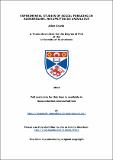Files in this item
Experimental studies of social foraging in budgerigars, Melopsittacus undulatus
Item metadata
| dc.contributor.advisor | Hoppitt, William | |
| dc.contributor.author | Cowie, Alice | |
| dc.coverage.spatial | 300 | en_US |
| dc.date.accessioned | 2015-04-23T13:54:38Z | |
| dc.date.available | 2015-04-23T13:54:38Z | |
| dc.date.issued | 2014-06-25 | |
| dc.identifier | uk.bl.ethos.644811 | |
| dc.identifier.uri | https://hdl.handle.net/10023/6552 | |
| dc.description.abstract | Many animals are social foragers. Foraging with others may confer a number of advantages, but is also likely to present a number of challenges that are not encountered by solitary foragers. For instance, whilst feeding in a group may interfere with an animal’s ability to learn new foraging skills or the location of new foraging patches by itself, it may simultaneously provide it with the opportunity to acquire new skills or knowledge by means of social learning. This thesis addresses a number of questions relating to the interaction between social foraging and social learning using small groups of captive budgerigars, Melopsittacus undulatus, as a test species. In particular, it investigates the spread of novel foraging behaviour through groups of birds under conditions that either permit or restrict a high degree of ‘scrounging’ (food stealing) by naïve birds from skilled ‘producers’ in their group (Chapter Three). Scrounging is found to inhibit naïve budgerigars’ performance of new foraging skills, but appears to facilitate their underlying acquisition, or motivation to acquire these skills, when the need arises – for instance, when producers are lost from their group. In addition, the thesis assesses the importance of a number of different individual-level characteristics, such as age, sex, and competitive rank, in predicting birds’ propensity to behave as producers rather than scroungers when foraging in a group (Chapter Four). The thesis also examines budgerigars’ relative use of social and personal information when selecting foraging locations (Chapter Five), and assesses the importance of group social networks in predicting individual birds’ order and latency to arrive at foraging patches (Chapter Six). Budgerigars are found to rely on social information when they lack any personal information about foraging locations. When equipped with both social information and personal information, some, but not all birds appear still to utilise social information. Birds’ social networks appear to have little bearing on individuals’ foraging patch visitation times. | en_US |
| dc.language.iso | en | en_US |
| dc.publisher | University of St Andrews | |
| dc.subject | Social learning | en_US |
| dc.subject | Social foraging | en_US |
| dc.subject | Budgerigar | en_US |
| dc.subject | Melopsittacus undulatus | en_US |
| dc.subject | Producer-scrounger game | en_US |
| dc.subject | Animal personalities | en_US |
| dc.subject | Network-based diffusion analysis | en_US |
| dc.subject.lcc | SF473.B8C7 | |
| dc.subject.lcsh | Budgerigar--Food | en_US |
| dc.subject.lcsh | Budgerigar--Behavior | en_US |
| dc.subject.lcsh | Social learning | en_US |
| dc.subject.lcsh | Learning in animals | en_US |
| dc.title | Experimental studies of social foraging in budgerigars, Melopsittacus undulatus | en_US |
| dc.type | Thesis | en_US |
| dc.contributor.sponsor | European Research Council (ERC) | en_US |
| dc.type.qualificationlevel | Doctoral | en_US |
| dc.type.qualificationname | PhD Doctor of Philosophy | en_US |
| dc.publisher.institution | The University of St Andrews | en_US |
This item appears in the following Collection(s)
Items in the St Andrews Research Repository are protected by copyright, with all rights reserved, unless otherwise indicated.

